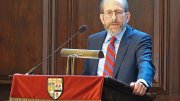In light of the University's November 10 announcement about possible budget reductions—as the financial and economic crisis causes the endowment to decline in value—it is more important than ever to have a clear picture of each school's financial position. President Drew Faust made it clear that school-by-school plans for belt-tightening are required, given their different circumstances (alongside University-wide measures such as reassessing the pace of major capital projects, including campus development in Allston). This update provides such data for each school or academic unit; reports on Faculty of Arts and Sciences (FAS) dean Michael Smith's letter to the faculty about the financial challenges facing the College and the Graduate School of Arts and Sciences; and links to other news coverage of the University's financial situation.
Endowment resources and income by school and academic unit. As previously reported, Harvard's endowment as a whole was valued at $36.9 billion as of last June 30, and distributions from the endowment contributed $1.2 billion, or about 34.5 percent, of operating revenue during fiscal year 2008. Following are data on the market value of each academic unit's endowment and its share of the whole, as of last June 30, and, for the principal academic units, the share of their fiscal year 2008 operating revenues from endowment distributions (see the Harvard University Financial Report, pages 3 and 5).
| School or Unit | Endowment in $Bil./% of Total | Revenues from Endowment Income |
| Arts and Sciences | $15.71/42.6% | 52% |
| Business | $ 2.96/ 8.0% | 20% |
| Dental | $ .23/ 0.6% | 24% |
| Design | $ .45/ 1.2% | 41% |
| Divinity | $ .66/ 1.8% | 71% |
| Education | $ .57/ 1.5% | 28% |
| Engineering & Applied Sciences | $1.03/ 2.8% | 39% |
| Government | $1.14/ 3.1% | 25% |
| Law | $1.90/ 5.2% | 37% |
| Medical | $4.32/11.7% | 25% |
| Public Health | $1.30/ 3.5% | 13% |
| Radcliffe Institute | $ .63/ 1.7% | 83% |
| President's Funds | $2.51/ 6.8% | |
| Auxiliary Depts. | $ .39/ 1.0% | |
| Central Admin. | $ .35/ 0.9% | |
| Other Academ. Depts. | $2.78/7.5% | |
| TOTAL | $36.9/100% |
FAS's situation. In a November 10 letter to the faculty, Dean Michael Smith wrote that "[W]e must recognize that the severe economic downturn has fundamentally changed how we must approach our current activities as well as plan for our future," necessitating measures beyond merely becoming more efficient. The challenge, he wrote, is "to deliver financial results this year that are below budget and create future budget scenarios that reduce our recurring expenses," requiring FAS "to take an even harder look at what we do and how we do it. The FAS is not unfamiliar with proverbial belt-tightening, but given the current crisis we will need to go significantly further." Given FAS's dependence on endowment income, he noted, "[W]e must consider budgeting scenarios that significantly reduce our annual operating expenses.
"The academic and administrative deans and I have already begun to think about how best to approach this unparalleled challenge," Smith continued. "I say that this is unparalleled, because we often consider how we might slow the growth of our expenses, but we almost never discuss how we can roll back the clock to spend less. The plans emerging from this challenge will almost certainly affect the FAS unevenly, although the size of this challenge will guarantee that every one of us will be affected in some way."
He promised further communications as plans unfold, even as he urged that the faculty guard against "allow[ing] prudent financial planning for worst-case scenarios to leak over and affect our programs. We don't know the future. We don't know how long this crisis will last or how severe it will be. We must approach it with eyes open, but be on guard to ensure that negativism does not prevail."
Other news coverage. For other news coverage of the University's announcement and financial situation, see the stories in the Boston Globe and the Harvard Crimson.








